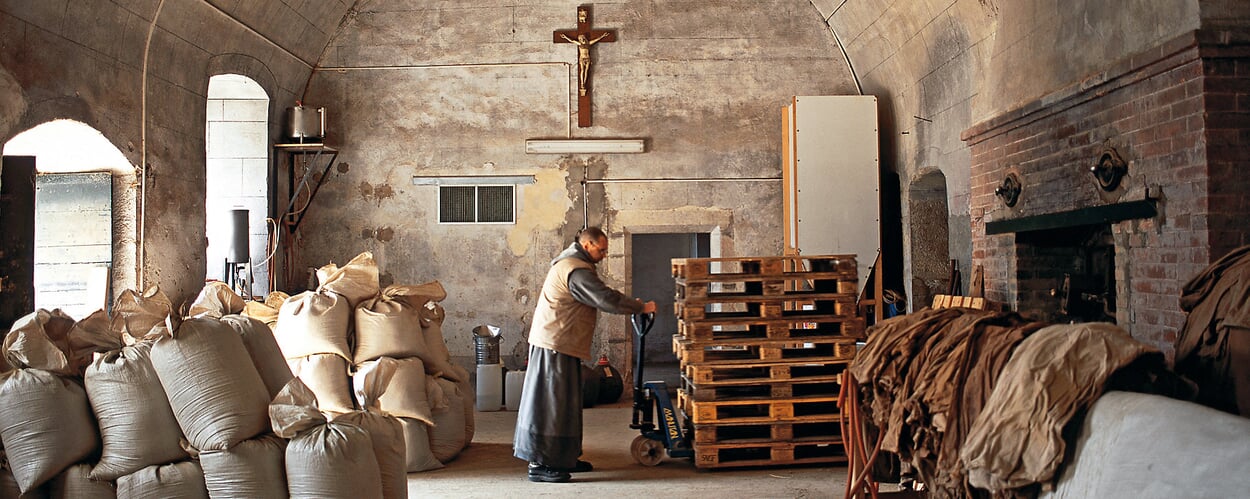Gutes aus Klöstern
Kartäuser. The cross stands while the world turns
Hermits known all over the world - isn't that a contradiction? Yes and no, when it comes to the Kartäuser. Who can know them, whose monasteries you cannot visit, not even their churches? They are hermits, have withdrawn from the world, do not socialize and love silence. After their death, not even a name will adorn their grave, only a simple cross made of wood. And this is only logical, because the motto of the Kartäuserorder is: Stat crux, dum volvitur orbis - the cross stands while the world turns. While the world turns, the Kartäuser spends his life in his monastery. And this has been the case ever since the order was founded by St. Bruno of Cologne, who in the 12th century, in search of ever more solitude and inwardness, found his place in the French Prealps: the mountain massif of the Chartreuse, from which the order took its name and where the great Charterhouse stands, the Grande Chartreuse, the mother monastery. Hermits do not live into the day, and the Kartäuser certainly not. Each monk has a small house, certainly spacious enough as a single dwelling, but sparsely furnished. He has nothing superfluous in it, but this house, the cell, is his microcosm. For there is also an "outside" for the Kartäuser, and that is his garden, which belongs to every house and is surrounded by high walls. Here the monk finds access to nature and opportunity for physical work, the necessary balance in a life full of prayer, meditation, study, reading. And then there is a third element besides spirit and nature: that of creation. It is a small workshop that every monk can do to his heart's content. Very popular are woodturning, bookbinding, blacksmithing. But here he does not have to produce anything that will be sold, but it is a place where he integrates his creative power and creativity into the spiritual. Kartäuser are not simply hermits, however, they are a community of hermits and meet on certain occasions. Especially for prayer in the church, especially at night. Because Kartäuser are extreme early risers. Their day begins as early as 11:30 p.m., and they devote many hours of the night to worship throughout their lives. But they are not extremists. The weekly silence is interrupted every Monday, because there is the walk since time immemorial. This is usually a long walk in the surroundings of the monastery, where they relax, talk to each other and exchange news. A necessary interruption of the strict silence, important to meet the human need for exchange and conversation. With joy, the Kartäuser point out that their order "has never had to be reformed because it has never been deformed". This may be due to the fact that there are always only a few Kartäuser (currently about two to three hundred worldwide), but also to the fact that their organizational structure is based on solidarity. For not every member of the order feels called to strict solitude in a Kartäuserhouse. Those who seek seclusion but need more activity will find both among the brothers. They have their own work areas and take care of the management of the monastery. Yes, they allow the hermits their completely purposeless and unavailable life, and this has proven itself over the centuries. But they also seek the silence of prayer as craftsmen, gardeners or farmers. And if a new machine can help to have more time for silence, then it is acquired. Yes, only if this time gained is not used for another activity. This is an interesting model that is worth discussing, especially since it is also quite successful economically. However, it is not so much the Kartäuser, as its liqueur that is world-famous. But it is also worth thinking about their way of life, their attitude toward having and being, because it is highly topical. Martin Erdmann
Chartreuse. The coincidence and its success story
The fact that one of the smallest orders became the largest monastic liqueur distillery of all is not due to an ancient monastic pharmacy or secret research, but first of all: to chance. In 1735, a French marshal gave the monks of the Grande Chartreuse the decisive recipe for the famous Élixir végétal, the mother of all other Chartreuse liqueurs. Unthinkable, however, to locate such a large operation in the solitude of the monastery. Therefore, the distillery is located in Voiron; it is run by employees. But the blending of the herbs is still the responsibility of the two monks, each of whom knows the recipe. They have to visit the site regularly to do this, but in the meantime they already control some things from the monastery: with the computer. Yes, it helps them not to have to interrupt their solitude more often than necessary. But from Voiron, the liqueur of the silent monks reaches the whole world!



